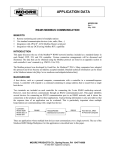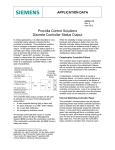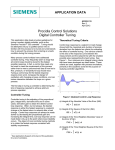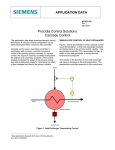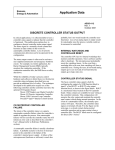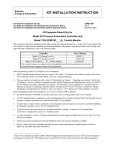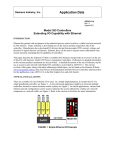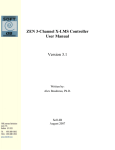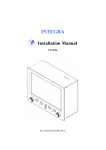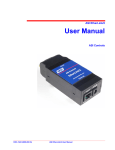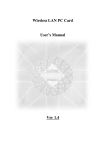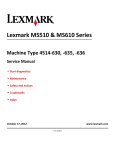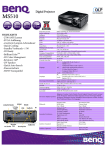Download Procidia Control Solutions Ethernet Peer-To-Peer
Transcript
APPLICATION DATA AD353-113 Rev. 2 April 2012 Procidia Control Solutions Ethernet Peer-To-Peer Communication Ethernet is a leading form of network communication that is often employed on industrial process networks. Data is exchanged between networkconnected, Ethernet-enabled process controllers, personal computers, and field instruments to control and monitor a process. This data can be shared throughout a company and, by way of the Internet, it can be made available to remote locations almost anywhere in the world. Presented here is an overview of peer-to-peer communication on a private Ethernet network that includes Procidia™ controllers. See Application Support on page 9 for a list of controllers. There are private and public networks. In this paper, we are concerned with the private network. A private network has access intentionally restricted to specific individuals, usually within a company or within one specific area within a company. Private networks can be linked for efficient exchange of data. Open access characterizes a public network. The Internet is an example of a public network where anyone with the requisite computer and software can log on. In this paper, we discuss what Ethernet is, describe building a network, and briefly introduce network addressing. Next, controller configuration and Ethernet function blocks are discussed. Finally, controller firmware and hardware requirements are listed. The scope of this paper is limited to introductory material. However, the References section on the last page has a list of books and manuals that provide indepth information about the above topics plus network security, wiring, and troubleshooting. Siemens offers training classes that include configuring a controller for Ethernet operation; see the References section. The final word though belongs to your company’s network administrator. He or she is a primary source of additional information about network security, design, IP addressing, and other critical network issues. Ethernet and Procidia Ethernet is simply an agreed upon set of rules that describes how devices will exchange messages. These rules are published in IEEE specification 802.3 and they describe in detail the critical aspects of Ethernet communication including the format of the data packets and the physical interconnections (cables and connectors). The Ethernet form used by Procidia controllers is Modbus TCP/IP (Transmission Control Protocol/Internet Protocol). 1 Messages are correctly addressed and routed by IP; TCP insures that all packets of data are received correctly. Simply stated, Modbus TCP/IP is Modbus communication encapsulated in an Ethernet TCP/IP wrapper. Before delving further into Ethernet, some Modbus characteristics need to be mentioned. Modbus is a common communications protocol supported by many instrument manufacturers. Modbus communication is based on one master device and one or more slave devices, each slave having a unique identity or address. Usually, the master is a PC or PLC. Slave devices can be controllers, slave PLC’s, and field instruments. Only the master can initiate communication and it can issue either a data request or a write data command. The Modbus command contains: the unique address of the slave to which the message is directed, the command function code, the starting register address, and the number of registers affected. 1 Procidia controllers (see page 9) are capable of Modbus TCP/IP and HTTP over 10BaseT and 100BaseT. AD353-113 the probability of collisions and significantly increase network traffic. The slave recognizes its address, performs the command operation, and sends a response. The response is either the data requested or a reply that it received the write command. The starting register address and the number of registers affected specifies the location and size of the data. On a Modbus network, the master must wait for the reply before issuing another request. This architecture does not allow peer-to-peer communication between slave devices. The controllers are Modbus slaves, by design, and respond to Modbus commands. To enable the controllers to initiate Ethernet peer-to-peer communication, Ethernet communication function blocks are included in firmware version 2.40 and higher. There are three function blocks that initiate communication: AIE (Analog Input for Ethernet communication), DIE (Digital Input for Ethernet) and CIE (Coil Input for Ethernet). Each block issues a data request command. Unlike Modbus, Ethernet communication supports peer-to-peer communication because it permits all devices, known as hosts in Ethernet parlance, to initiate communication. In Figure 1, three hosts are connected together through a hub forming a network. Any host can send a message through the hub to the other hosts. However, only one host at a time can send a message. If two hosts do send messages at the same time, the messages collide and become unreadable. The compliments to the above blocks are the AOE (Analog Output for Ethernet) and DOE (Digital Output for Ethernet) function blocks. These blocks do not initiate communication. They map data to the controller’s Modbus registers (memory locations) where the data are stored. Data in the Modbus registers are available to the network. Note that controllers cannot initiate write commands. This privilege belongs to an operator who can initiate actions through an HMI, such as a Procidia i|station. Hub Building a Network s 2 4 2 3. 4 5 S 100 P L S 80 AC K 60 D PB2 40 A M 20 UNITS 0 LOOP 0 CLOSE | | || The manner in which hosts are connected together to create a network is referred to as the network topology. This includes the cabling of the networkconnected hosts and the use of hubs, switches, routers and gateways to accommodate that cabling and create the desired network structure. Figures 1 and 2 show simple networks. Figure 3 shows two networks connected through a router. These arrangements or topologies will be discussed in this section. Ethernet Enabled Field Device, Address 2 T C2 0 5 3 . P PB1 100 OPEN X03141 S2 Model 353, Address 3 Control Room HMI, Address 1 MG00422a Model 353 Figure 1 Hub-Based Ethernet Network Each host connected to a network must have a unique identifier known as an address -- equivalent in purpose to your home address for Post Office mail delivery. In Figure 1, the addresses are 1, 2, and 3. A message can be sent, for example, from the HMI at address 1 to the controller at address 3; the field instrument at address 2 will receive the message but ignore it since the message was not addressed to it. This is point-to-point or peer-to-peer communication. Broadcast communication allows a host to send a message to all other network-connected devices. Collision avoidance is built into Ethernet through the use of CSMA/CD (Carrier Sensing Multiple Access with Collision Detection). When a host needs to send a message, it first listens to the network, to determine if another host is sending a message. After a short period of network inactivity, the host sends its message. If another host attempts to send a message at the same instant, both stop and wait a random length of time before attempting to re-send their messages. Since each host’s wait time is random, the previous communication collision is unlikely to be repeated. However, each collision and ensuing wait time reduces the volume of traffic that can flow on the network. The design of the network can reduce 2 AD353-113 Switch s s 2 4 2 3. 4 5 2 4 2 3. 4 5 S 100 S P L S 80 AC K PB1 D PB2 40 A M 100 P L S 80 AC K 60 60 PB2 20 D 40 A M UNITS 20 UNITS 0 0 LOOP LOOP | | | 100 0 CLOSE OPEN | | | 100 OPEN Model 353 Model 353 X03141 S2 MG00422a 0 CLOSE Ethernet Enabled Field Device, Address 2 T C2 0 5 3 . P T C2 0 5 3 . P PB1 X03141 S2 Model 353, Address 4 Model 353, Address 1 Control Room HMI, Address 3 Figure 2 Switch-Based Ethernet Network PC in Purchasing PC in Accounting Internet Web Server Gateway Switch Router Note: Router/Switch combination may be two separate devices. Office Area Network Process Area Network MG00422a Router Switch s s 2 4 2 3. 4 5 T C2 0 5 3 . P S PB1 100 2 4 2 3. 4 5 S L 80 S AC K PB1 D PB2 UNITS A M P L 80 S AC K 20 D 40 40 20 UNITS 0 0 LOOP LOOP 0 CLOSE 100 60 60 PB2 A M Ethernet Enabled Field Device T C2 0 5 3 . P P | | | 100 0 OPEN Model 353 X03141 S2 Model 353 CLOSE | | | 100 OPEN Model 353 X03141 S2 Model 353 Control Room HMI Figure 3 Ethernet Network with Router and Gateway 3 To/From Internet AD353-113 Many people will participate in the design of the network. Your company’s network administrator will play a primary role by examining security issues, assigning addresses, and deciding other critical issues. Process engineering will identify the equipment that is to be connected to the Ethernet network. Company management may be interested in connecting a network that links the purchasing and accounting departments to the process control network. If remote monitoring is required, an intranet, extranet, or the Internet may also be connected. Network reliability and security will be of immense concern to all involved. Router or Gateway-Connected Networks A router is used to connect together networks of the same type, for example, two Ethernet networks. Figure 3 shows two routers with built-in switches connecting a process area network to an office area network. The office network includes the purchasing and accounting departments, and a web server and gateway with a security firewall for access to the Internet. A router can read an address and route a message to the proper network and to the addressed host. In addition, a router isolates the networks and can usually prevent a problem on one network from affecting other connected networks. Network performance and reliability are significantly improved. Ethernet Network with a Hub In Figure 1, a hub is used to connect the controller, field instrument, and HMI. The hub is simply a central point to which a number of hosts, often as many as 8-12, can be electrically connected. Every message sent by a host is sent to every other connected host but read by only the addressed host. The hub distributes the message but, since it is a passive device, it cannot direct the message only to the addressed host. A gateway is a general term for devices that link two networks together, and the router is a member of the gateway class. A gateway is often able to connect two different types of networks together, for example, connecting an Ethernet network to an IBM SNA (System Network Architecture) network. A public network, such as the Internet, can be connected to a private network through a gateway or a router. For information about configuring a gateway or router, refer to the manufacturer’s installation manual. As pointed out earlier, a collision occurs when two hosts try to send a message at the same instant. With only three hosts, network performance is probably adequate. However, as additional hosts are connected to accommodate plant or process expansion, network performance suffers. Since only one host at a time can access the network and there are now more hosts, network traffic increases, the number of collisions increases, and performance degrades. The use of a hub to interconnect hosts is generally not recommended. The solution is to replace the hub with a switch, also known as a switching hub. IP Address Ethernet Network with a Switch This section introduces IP addressing. Addressing is a complex topic, particularly when several networks and sub-networks are involved. Your company’s network administrator will supply host addresses, masks, subnet addresses, and gateway addresses as needed. Addressing is an inseparable part of network design. A switch, like a hub, interconnects hosts. However, the switch directs traffic more effectively since it can read addresses and route a message directly to the addressed host. In Figure 2, a message sent by host 1 to host 2 is not sent to hosts 3 and 4. Indeed, at the same time hosts 1 and 2 are communicating, hosts 3 and 4 can be communicating. The switch isolates the simultaneous communications allowing an increase in network traffic while reducing message collisions. Every host on a network needs a unique address. In Figure 1, addresses 1, 2, and 3 were used. The Internet Protocol (IP) uses a 32-bit addressing structure. An example of an IP address is 192.168.0.2. Notice that the complete address is written as four numbers in a dotted-decimal notation, i.e. the four decimal groups are connected together by three dots. Each decimal number has a range of 0 to 255. 4 AD353-113 A portion of the complete address represents the network address (netid); another portion the subnet address (subnetid), on a more complex network; and a third portion the host address (hostid). However, it is important to remember that all four decimal numbers provide the complete address. A brief example of the use of subnet addresses and subnet masks is provided later in this paper. If the network is not connected to another network, particularly the Internet, almost any IP addresses can be assigned. However, the IANA (Internet Assigned Numbers Authority) has reserved three blocks of addresses for private networks. These reserved address ranges should be used whether or not a connection to a public network is anticipated. through through through 192.168.0.0 192.168.255.255 or 172.16.0.0 172.31.255.255 or 10.0.0.0 10.255.255.255 Figure 4 Sample Windows TCP/IP Properties Dialog Box A default address is provided by a controller. It can be used in many applications where the process control network is not connected to other networks. When a Windows®-based PC is to be configured, make the needed entries in the dialog box shown in Figure 4. Your network administrator can provide addresses, subnet masks, and other necessary information. network-connected controller from which data or status will be obtained. Make a list of each Ethernet discrete input block created and the loop where it is located. Where a discrete value is to be stored in the controller’s Modbus registers, add a DOE block to the configuration. Note this register location for later connection. Peer-to -Peer Configuration To configure peer-to-peer communication between controllers, build each controller’s configuration as you normally would. Wherever an external analog value or point is to be exchanged over Ethernet, add an AIE or AOE function block to the configuration. Note that more than one AIE block can request data from a single AOE block. Make a list of each Ethernet analog block created and the loop where it is located for later connection. When finished, return to each configuration and tie the Ethernet I/O blocks. Next, assign IP addresses to each controller 2 . The last step is to go through each AIE and DIE function block and set the source IP address and Modbus register location. Where an external discrete value or point is to be acquired over Ethernet, add a DIE block. Since the DIE block supports 16 points, it is likely that several loops will need to connect to it. Create a separate I/O Discrete loop and place one DIE block for each 2 A default controller address is provided. One controller on a network can use this address. A unique address will need to be assigned to each additional controller. 5 AD353-113 Ethernet Function Block ETH DPLX (Ethernet Duplex mode) The ETHERNET function block is used to assign the controller IP address and to set communication parameters. The ETHERNET function block is located under Station Function Blocks. The Ethernet Duplex mode parameter specifies how devices (e.g. switches, routers) communicate with each other. It is recommended to set ETH DPLX parameter to Automatic mode. When the host registers with the switch (or gateway), it establishes the communication mode. The Full-Duplex and Half-Duplex mode options are available in the event that other hosts on the network support only one mode. Consult with the network administrator before making a selection other than that recommended here. IP ADRES (IP Address) Each controller requires a unique IP address. Enter the address assigned by the network administrator. Alternatively, if this is a private network, use an address from the blocks of reserved IP addresses listed earlier in this paper. ETH Rate IP MASK (Subnet Mask) This Ethernet Rate parameter refers to more than the communication baud rate. It refers to the network wiring specification and topology. Most hosts can support both Ethernet 10BASE-T (10 mbps) and 100BASE-T (100 mbps). Set the ETH RATE parameter to Automatic. When the host registers with the switch (or gateway), it establishes the baud rate for each connection. The 10BASE-T and 100BASE-T options are available for unique network topologies. Consult with the network administrator before making a selection other than that recommended here. The subnet mask is the method used to identify messages that are addressed to members of a subnet. More than one subnet can exist in the same network. If the subnet address is 192.168.175.0, then use IP mask 255.255.255.0. If the subnet address is 192.168.175.128, then use IP mask 255.255.255.128. Your network administrator will provide the needed addresses and masks. Figure 5 is an example of bit-wise logic illustrates how the subnet mask works: • • • • IP Address Subnet Mask AND bit logic Subnet Address 11000000 10101000 10101111 00000010 11111111 11111111 11111111 00000000 (192.168.175.2) (255.255.255.0) 11000000 10101000 10101111 00000000 (192.168.175.0) Figure 5 Subnet Mask Example IP GATE (Gateway IP Address) When using a switch, each host-to-switch connection can be set for either 10BASE-T or 100BASE-T. If the local network is isolated by a gateway, then the gateway IP address needs to be specified. Typically, it is assigned the first host address in the subnet, e.g. 192.168.175.1 or 192.168.175.129. P2P RATE (Peer-to-Peer Communication Rate) The Peer-to-Peer parameter specifies in seconds how often the controller issues a data request command. A gateway address must be assigned. If a gateway is not present, the gateway field should contain an unused address within the host subnet (address range). 6 AD353-113 AIE Function Block The plant master controller will have the compliment AOE block. The purpose of the AOE block is to provide a memory location for the plant FRD value. The plant master controller, being a Modbus slave, will respond with the value located in the specified Modbus registers. The AIE function block is used to request analog data from another controller on the network. In a typical application, a supervisory controller provides an external set point to a loop controller. Thirty-two (32) AIE blocks are available per controller. Example: In a steam powerhouse application, the plant master controller regulates the main steam header pressure. All boilers are connected to the main header and the header provides steam to the plant. Each boiler controller relies on the plant master to dictate the percentage of full capacity at which it should be running. This value is the plant fire rate demand (FRD). IP ADRES (Source IP Address) The IP address of the source controller is required. MB REG (Modbus Register) To transfer the plant FRD across an Ethernet network, each boiler controller will contain an AIE function block in the boiler master loop. See Figure 6. It replaces the AIN function block used with traditional field wiring. The boiler controller will periodically issue a data request command to get the latest plant FRD. MG00422a Embedded within the Modbus command is the starting register address and the number of consecutive registers to be read. The function block assumes that the data is in IEEE floating point format and it requests two registers of data. (A register is 16 bits). For convenience, the starting register for each AOE is listed in the User’s Manual under the AIE function block section. Switch s s s 2 4 2 3. 4 5 2 4 2 3. 4 5 T C2 0 5 3 . P T C2 0 5 3 . P S PB1 100 S P L S 80 PB1 ACK S L S AC K PB1 D PB2 UNITS A M 20 40 A M U NITS 0 | | | | CLOSE OPEN | 100 0 OPEN CLOSE I/O Discrete DOE1 DOE2 AIE1 I/O Discrete I/O Discrete DOE1 DIE1 Figure 6 Ethernet Peer-To-Peer Communication 7 | 100 OPEN Boiler Master AIE1 DIE1 | Boiler 2 Boiler Master AOE1 | X 03141 S2 Boiler 1 Steam Pressure D Model 353 X 03141 S2 X 03141 S2 DIE2 | Model 353 Plant Master ACK UNITS LOOP 0 100 Model 353 S 0 LOOP CLOSE L 20 0 LOOP P 80 40 20 0 100 60 PB2 D 40 DIE1 2 4 2 3. 4 5 T C2 0 5 3 . P P 80 60 60 PB2 A M 100 DOE1 AD353-113 Data can be requested from registers other than AOE blocks. For example, the process, set point and valve variables can be read directly from the ODC block. Be sure to select the Modbus registers from the Dynamic Loop Floating Point Data (IEEE) and not the Dynamic Loop Integer Data. AOE Function Block It is possible to request IEEE formatted data from other hosts that support Modbus TCP/IP protocol. The default host Modbus address is 1. The AOE block does not contain scaling information. If the associated AIE block is requesting scaling information (Range is Automatic mode), then the AOE range pointer must be configured to an appropriate analog input or scalar function block. Refer to the controller’s User’s Manual for additional information about this block. The AOE function block is used to map analog data to the Modbus registers, to make it available to the network (i.e. the AIE block in another controller). Thirty-two (32) AOE blocks are available per controller. Important: The AIE function block assumes that data is in IEEE format and request two registers of data. Range DIE Function Block When data is to be displayed in the controller or i|station faceplate, scaling information is important. This information also affects the performance of the PID and other loop function blocks. The standard procedure is to assign the MINSCALE, MAXSCALE, DPP and ENGUNITS parameters of an analog input block. When the RANGE parameter is in Automatic mode, scaling information comes from the AOE block in the source controller. In Manual mode, the scaling information specified in the AIE function block parameters is used. In the Auto mode, the advantage of this parameter is that any changes made to the scaling parameters of the source controller are applied to all other controllers in the network. It is good engineering practice to configure all range pointers. The default setting is Manual mode. The DIE function block is used to request discrete data from a second controller on the network. Thirtytwo (32) DIE function blocks are available per controller. Each DIE function block supports 16 discrete points. A separate DIE block is required for each controller from which data is requested. Refer to the controller’s User’s Manual for additional information about this block. Note: In Procidia controllers, discrete data is normally stored in the Modbus coils. Since this command issues a read register command, it cannot be used to request controller discrete data. The CIE block issues the read coil data command. IP ADRES (IP Address) The IP address of the source controller is required. MB REG (Modbus Register) Important: If requested data does not come from an AOE block, set the RANGE parameter to Manual and set the MINSCALE, MAXSCALE, DPP, and ENGUNITS parameters appropriately. See the controller’s User’s Manual. Embedded within the Modbus command is the starting register address and the number of consecutive registers to be read. The function block assumes that the data is in bit format and requests one register of data. (A register is 16 bits). For convenience, the starting register for each DOE is listed in the User’s Manual under the DIE function block section. Note: Since data is transferred in IEEE format, the value is not altered. 8 AD353-113 Application support Important: The DIE block assumes that data is in bit format and requests one register of data. User manuals for controllers and transmitters, addresses of Siemens sales representatives, and more application data sheets can be found at www.usa.siemens.com/ia. To reach the process controller page, click Process Instrumentation and then Process Controllers and Recorders. To select the type of assistance desired, click Support (in the right-hand column). See AD353-138 for a list of Application Data sheets. DOE Function Block The DOE function block is the compliment of the DIE. This block maps the discrete outputs of other function blocks to the Modbus registers. Thirty-two (32) blocks are available per controller and 16 points can be configured per block. Refer to the controller’s User’s Manual for additional information about this block. The controller configurations discussed in this publication can be implemented with the Siemens i|config™ Graphical Configuration Utility. CIE Function Block Controller Firmware and Hardware Requirements The CIE function block is used to request discrete coil data from another controller on the network. Thirty-two (32) CIE function blocks are available per controller. Each CIE function block can obtain up to 16 consecutive coils. There is no compliment block for the CIE. Refer to the controller’s User’s Manual for additional information about this block. The following Procidia controllers are Ethernet capable when the listed firmware and hardware items are installed. Model 353R with: Modbus coils are memory locations where discrete data is stored in bit format. Coils are different than registers and can be visualized as a different sector in memory. Coils have their own set of data request and write commands. Controller discrete logic data is available as outputs of function blocks. In peer-to-peer communication, use DIE and DOE blocks where needed to transfer discrete data. This method is recommended over using the CIE block because, when using the Graphical Configuration Utility, the controller configuration is more thoroughly documented. The CIE is available for completeness and it allows access to certain discrete statuses that are not available via function block outputs. It may be of value, for example, to know if an alarm has been acknowledged or that a controller is in run mode (station coil 00008). • Design Level “B” Controller Carrier TGX:353RRCCB_ • i|pac Ethernet Communication Board • Firmware V2.40 or higher Procidia i|pac Internet Control System* with: • Design Level “B” Controller Carrier Model iPAC-CC-B4 • i|pac Ethernet Communication Board • Firmware V2.40 or higher Model 353 Process Automation Controller Design Level B or Design Level A* with: 9 • Mounting Case Option 4 with RJ-45 Ethernet connector (Model 353_4...) • Model 353 Ethernet Communication Board • Firmware V2.40 or higher * Discontinued model AD353-113 References • SAMS Teach Yourself Networking in 24 Hours, Matt Hayden, SAMS Publishing, 2001 • Networking with Microsoft TCP/IP, Drew Heywood, New Riders Publishing • Networking Complete, Second Edition, Sybex, Inc., 2001 • Procidia i|pac User’s Manual, UMiPAC-1, Rev. 4 or higher • Model 353 Process Automation Controller User’s Manual, UM353-1, Rev. 9 or higher • Siemens Controller Configuration Training Class For information, follow the navigation on the previous page and click Training or request information from: Siemens Industry, Inc. Technical Training Center, MS510 1201 Sumneytown Pike P.O. Box 900 Spring House, PA 19477-0900 Procidia, i|pac, i|ware, i|config, and 352Plus are trademarks of Siemens Industry, Inc. Other trademarks are the property of their respective owners. All product designations may be trademarks or product names of Siemens Industry, Inc. or other supplier companies whose use by third parties for their own purposes could violate the rights of the owners. Control circuits are provided only to assist customers in developing individual applications. Before implementing any control circuit, it should be thoroughly tested under all process conditions. Siemens Industry, Inc. is not responsible for changes to product functionality after the publication of this document. Customers are urged to consult with a Siemens Industry, Inc. sales representative to confirm the applicability of the information in this document to the product they purchased. Siemens Industry, Inc. assumes no liability for errors or omissions in this document or for the application and use of information in this document. The information herein is subject to change without notice. Copyright © 2012, Siemens Industry, Inc. 10










